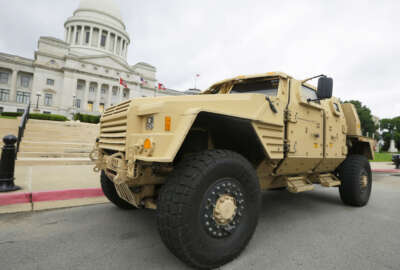
DoD plans for government shutdown, says little it can do to mitigate damage
Pentagon officials said Thursday that they have tweaked their government shutdown contingency plans since the last time one occurred in 2013, but emphasized that...
Subscribe to Federal Drive’s daily audio interviews on iTunes or PodcastOne.
Congress temporarily staved off a government shutdown on Thursday evening with its passage of a short-term government funding bill, but that’s cold comfort for top brass and managers at the Defense Department. It leaves another shutdown threat looming just two weeks from now, and in the meantime, keeps the government afloat via yet another continuing resolution, the haphazard funding mechanism the Pentagon says has been the chief contributor to an erosion of military readiness over the past decade.
The underlying matters that prevented Congress from passing a full-year 2018 appropriations bill three months ago were no closer to a resolution on Thursday. The looming issue is the multi-year budget caps the executive and legislative branches agreed to in 2011. In the case of Defense, they limit spending to $54 billion less than the administration requested for fiscal 2018.
In light of that uncertainty, Pentagon leaders have spent the last several weeks dusting off their contingency plans for a government shutdown. Those plans have been updated since the last shutdown in 2013, but officials say there’s very little they can do to make a shutdown run smoothly. If a shutdown happens, it would look a lot like the one that happened a little over four years ago.
In the absence of appropriations, uniformed military personnel would be expected to carry out their missions, but many civilians and contractors would be ordered to stop all work except for what’s needed to execute an orderly shutdown.
In any case, “No one gets paid,” David Norquist, DoD’s comptroller and chief financial officer told reporters Thursday afternoon. “The civilians who report to duty do not get paid. The military who are in theater do not get paid. They earn the rights to the payment, but the payment cannot be made until the shutdown is over. That is not a way for us to be treating the members and women of the armed forces.”
The Pentagon did not provide an updated estimate for how many civilians would be furloughed in the event of a shutdown, saying only that they would be sent home unless their jobs involved an “excepted activity” — those needed to ensure safety of property or life.
During the 16-day 2013 shutdown, the Pentagon initially exempted about half its civilians from furlough, but roughly 400,000 were required to stay home without pay. DoD eventually brought most of those employees back to work, but with few exceptions — such as employees paid from nonappropriated funds — the workers went unpaid until Congress passed a measure to make both furloughed and non-furloughed workers whole.
Norquist said the number of civilians furloughed in this potential shutdown would be highly dependent on how long it lasted.
“If they worked on excepted activities then they would be brought back in,” he said. “There are probably some things where one doesn’t need them for a few days, but if the shutdown goes on longer, they would be considered necessary to be excepted, so, we’ll just have to see how that goes.”
The situation is similar for DoD contractors: even if they are working on contracts that have already been fully-funded with past appropriations, they may be required to stop work if it’s not for an excepted activity, or if the government personnel required to supervise their work are furloughed.
“I cannot emphasize too much how destructive a shutdown is,” Norquist said. “We’ve talked a lot the importance of maintenance on weapons systems, but if it’s not an excepted activity, there will be a work stoppage on many of those maintenance functions. And that’s not recoverable time, right? If you’re supposed to do a certain amount of helicopter maintenance, you lose a day, a week, you’re just behind schedule, which then disrupts everything else.”
Other routine payments would be disrupted, including death benefits to families of military members killed in the line of duty, officials said. In general, the department would not be allowed to incur any new obligations, but there are some exceptions.
For example, a rarely-invoked mid-19th century law, the Feed and Forage Act, gives the military explicit permission to contract for essential supplies, even in the absence of congressional appropriations. But the department’s most current guidance tells officials that they should only enter into new contracts if delaying them would create an imminent risk to human life, property or national security.
Norquist said a shutdown would also almost certainly force the department to waste an untold amount of money simply by virtue of the actions it must take to cease and restart all of its non-excepted activities.
“I’ll give you what sounds almost like a trivial example: you take somebody and you send them off to training, then the government shuts down, and the instructions are that they need to come home,” he said. “So we buy them an airplane ticket to come home, they then miss the week of whatever the school of training was supposed to do, and when the shutdown ends, we pay to send them back. Now they join their activity midcycle. So those types of things cascade throughout the organization in ways that are just wasteful of taxpayer’s money.”
The two-week funding bill to sustain government operations through Dec. 22 avoids all of those eventualities for now, but officials emphasized that any period during which the department operates under a continuing resolution represents a setback.
“Nothing’s had a greater impact on combat readiness than CRs,” said Dana White, the Pentagon’s chief spokeswoman, adding that DoD has been funded by continuing resolutions instead of full appropriations bills for a collective 1,081 days over the last nine years. “At a time where security threats are high, we really do need the predictability in the budget that we certainly don’t have with CRs.”
Latest Defense News
Although less disruptive than government shutdowns, CRs are, by their nature, disruptive nonetheless, Norquist said. As an example, he pointed to the Trump administration’s 2018 budget request to buy additional munitions to replace those that were depleted in the fight against the Islamic State over the past year, a request that Congressional appropriators and authorizers have already endorsed.
“What the CR says is, ‘Stop, wait, don’t award that contract yet,’ which delays when you begin to increase the quantity and the production,” he said. “There are two very destructive effects of that. One is we’re delayed in meeting the requirements of the combatant commanders. The other one is there are companies out there willing to hire people to begin to meet our requirements, and you’re not getting the benefit on the economic side of that employment. So two weeks does that for two weeks, a month does that for a month. The answer is really, none of this is fixed until you get a proper appropriation bill.”
Sen. John McCain (R-Ariz.), the chairman of the Senate Armed Services Committee, was one of only a handful of Republicans to vote against the continuing resolution Thursday, saying Congress’ reliance on yet another short-term spending bill was “both disappointing and unacceptable.”
“Every day we spend on a continuing resolution is a day that our military must try to do more with less, modernization is delayed, and readiness is degraded,” McCain said. “For that reason, I cannot support this continuing resolution. The president and an overwhelming majority of Congress agree we need to increase investment in the military to rebuild our forces. This will only be possible with a bipartisan budget agreement. I hope that following today’s meeting between congressional leaders and the White House, that budget agreement will provide for substantial, sustained growth to defense spending for this year and next.”
Copyright © 2025 Federal News Network. All rights reserved. This website is not intended for users located within the European Economic Area.
Jared Serbu is deputy editor of Federal News Network and reports on the Defense Department’s contracting, legislative, workforce and IT issues.
Follow @jserbuWFED






